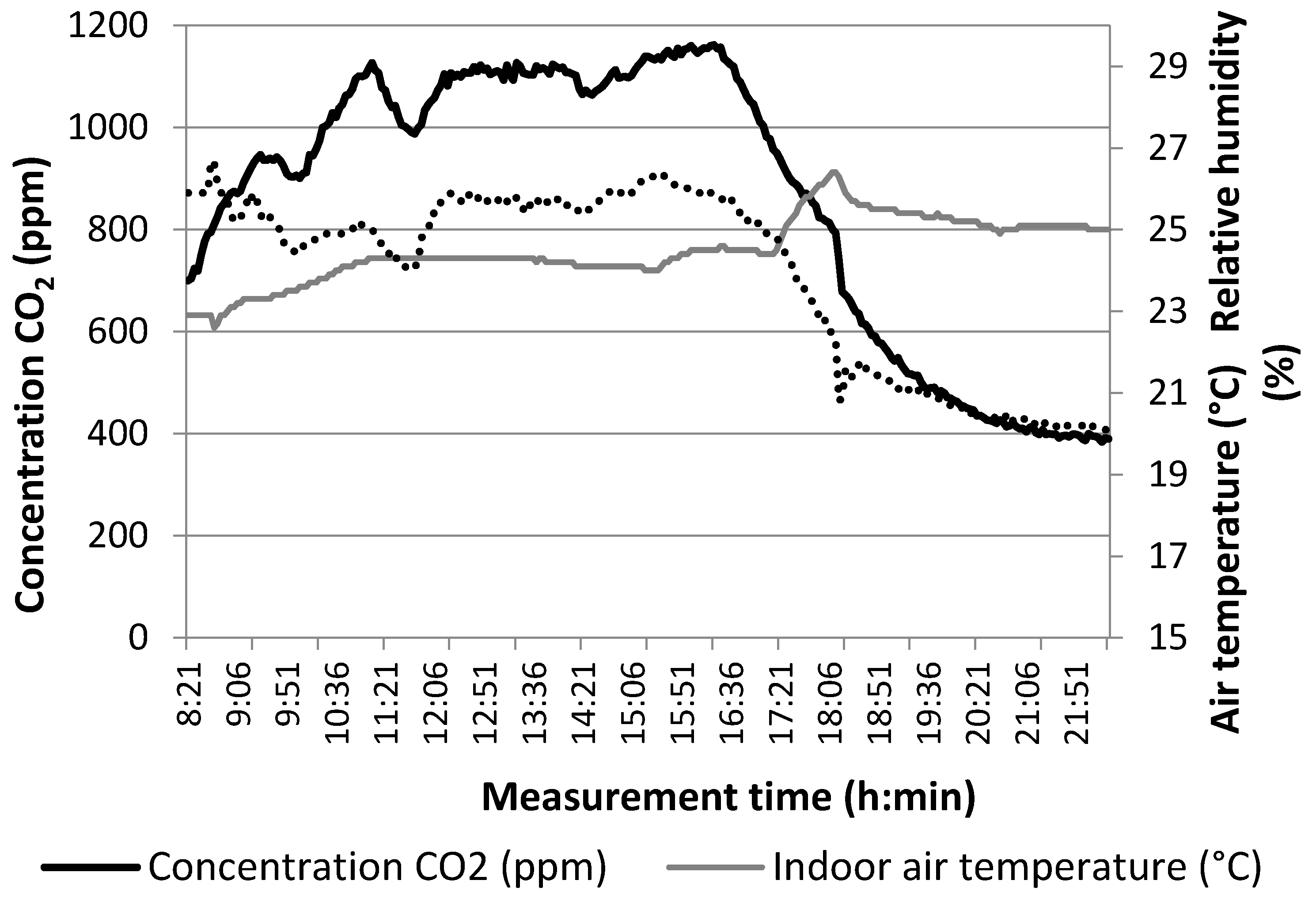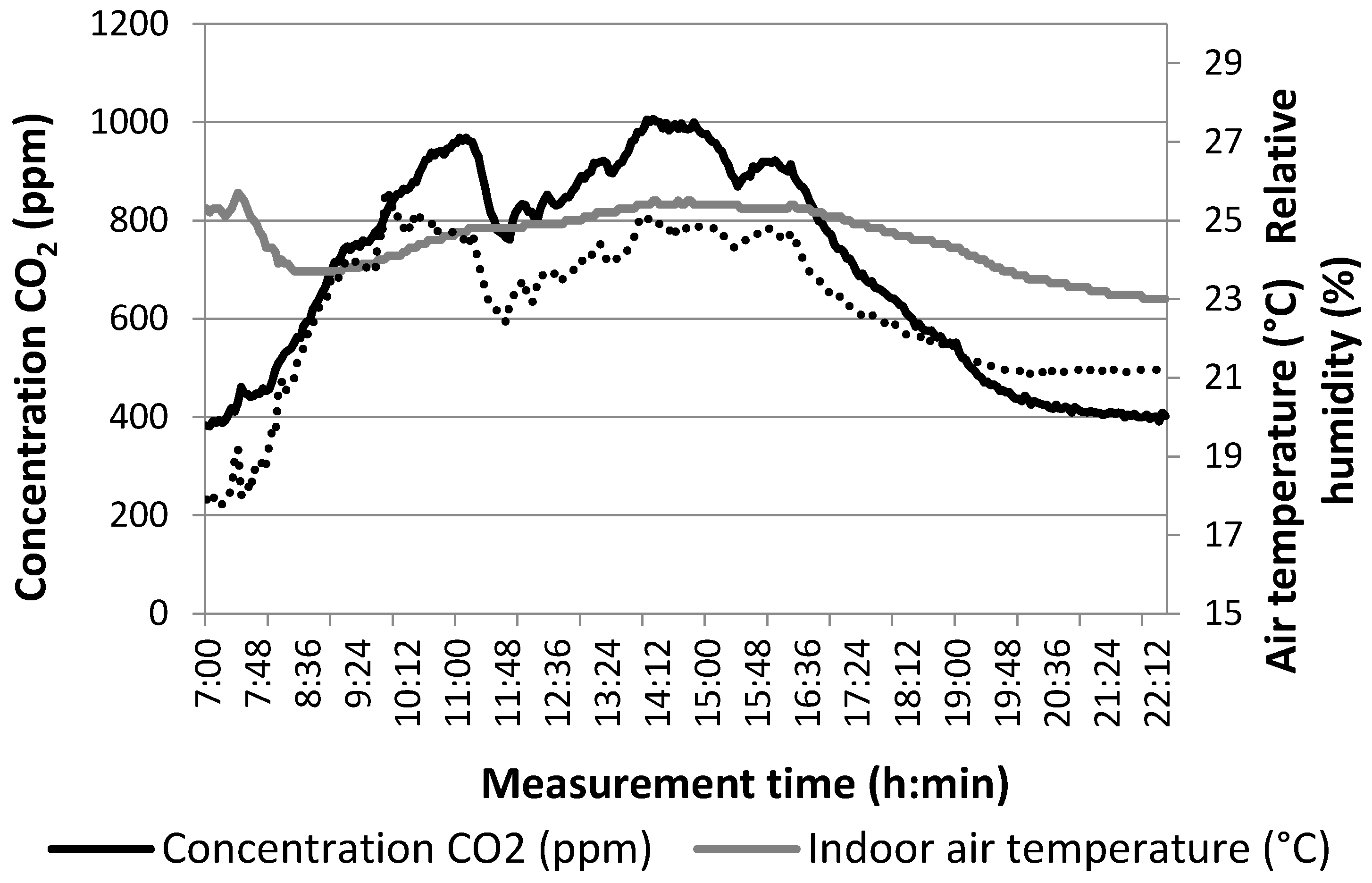Influence of Indoor Climate on Employees in Office Buildings—A Case Study
Abstract
1. Introduction
2. Materials and Methods
2.1. Site Description
2.2. Objective Measurement
2.3. Subjective Evaluation
3. Results and Discussion
3.1. Office A
3.2. Office B
3.3. Office C
3.4. Human Pulse
3.5. Subjective Evaluation
4. Conclusions
Author Contributions
Funding
Acknowledgments
Conflicts of Interest
References
- Shiram, S.; Rammamurthy, K.; Ramakrishnan, S. Effect of occupant-induced indoor CO2 concentration and bioeffluents on human physiology using a spirometric test. Build. Environ. 2019, 149, 58–67. [Google Scholar] [CrossRef]
- Liu, Y.; Wang, Z.; Zhang, Z.; Hong, J.; Lin, B. Investigation on the indoor environment quality of health care facilities in China. Build. Environ. 2018, 141, 273–287. [Google Scholar] [CrossRef]
- Mahyuddin, N.; Awbi, H. The spatial distribution of carbon dioxide in an environmental test chamber. Build. Environ. 2010, 45, 1993–2001. [Google Scholar] [CrossRef]
- Hsu, Y.C.; Kung, P.Y.; Wu, T.N.; Shen, Y.H. Characterization of indoor-air bioaerosols in Southern Taiwan. Aerosol Air Qual. Res. 2012, 12, 651–661. [Google Scholar] [CrossRef]
- Datta, A.; Suresh, R.; Gupta, A.; Singh, D.; Kulshrestha, P. Indoor air quality of non-residential urban buildings in Delhi, India. Int. J. Sustain. Built Environ. 2017, 6, 412–420. [Google Scholar] [CrossRef]
- Budaiová, Z.; Vilčeková, S. Assessing the effect of indoor environmental quality on productivity at office work. Sel. Sci. Pap. J. Civ. Eng. 2015, 10, 37–46. [Google Scholar] [CrossRef]
- Mahyuddin, N.; Awbi, H. A review of CO2 measurement procedures in ventilation research. Int. J. Vent. 2012, 10, 353–370. [Google Scholar] [CrossRef]
- Erdmann, C.A.; Apte, M.G. Mucous membrane and lower respiratory building related symptoms in relation to indoor carbon dioxide concentrations in the 100-building BASE dataset. Indoor Air. 2004, 14 (Suppl. 8), 127–134. [Google Scholar] [CrossRef]
- Tsai, D.H.; Lin, J.S.; Chan, C.C. Office workers’ sick building syndrome and indoor carbon dioxide concentrations. J. Occup. Environ. Hyg. 2012, 9, 345–351. [Google Scholar] [CrossRef]
- WHO. Indoor Air Quality: Biological Contaminants: Report on a WHO Meeting, Ruatavaara, 29 Augustȁ32 September 1988; European series. No. 31; WHO Regional Publications: Copenhagen, Denmark, 1988. [Google Scholar]
- Zamani, M.E.; Jalaluding, J.; Shaharom, N. Indoor air quality and prevalence of sick building syndrome among office workers in two different offices in Selangor. Am. J. Appl. Sci. 2013, 10, 1140. [Google Scholar] [CrossRef]
- Seppänen, O.A.; Fisk, W.J.; Mendell, M.J. Association of ventilation rates and CO2 concentrations with health and other responses in commercial and institutional buildings. Indoor Air. 1999, 9, 226–252. [Google Scholar] [CrossRef]
- Vehviläinen, T.; Lindholm, H.; Rintamäki, H.; Pääkkönen, R.; Hirvonen, A.; Niemi, O.; Vinha, J. High indoor CO2 concentrations in an office environment increases the transcutaneous CO2 level and sleepiness during cognitive work. J. Occup. Environ. Hyg. 2016, 13, 19–29. [Google Scholar] [CrossRef] [PubMed]
- Allen, J.G.; MacNaughton, P.; Cedeno-Laurent, J.G.; Cao, X.; Flanigan, S.; Vllarino, J.; Rueda, F.; Donnelly-McLay, D.; Spengler, J.D. Airplane pilot flight performance on 21 manoeuvres in a flight simulator under varying carbon dioxide concentrations. J. Expo. Sci. Environ. Epidemiol. 2018, 29, 457–468. [Google Scholar] [CrossRef]
- Allen, J.G.; MacNaughton, P.; Satish, U.; Santanam, S.; Vallarino, J.; Spengler, J.D. Associations of cognitive function scores with carbon dioxide, ventilation, and volatile organic compound exposures in office workers: A controlled exposure study of green and conventional office environments. Environ. Health Perspect. 2016, 124, 805–812. [Google Scholar] [CrossRef] [PubMed]
- Satish, U.; Mendell, M.J.; Shekhar, K.; Hotchi, T.; Sullivan, D.; Steufert, S.; Fisk, W.J. Is CO2 an indoor pollutant? Direct effects of low-to moderate CO2 concentrations on human decision-making performance. Environ. Health Perspect. 2012, 120, 1671–1677. [Google Scholar] [CrossRef] [PubMed]
- Kajtár, L.; Herczeg, L. Influence of carbon-dioxide concentration on human well-being and intensity of mental work. QJ Hung. Meteorol. Serv. 2012, 116, 145–169. [Google Scholar]
- Voznyak, O.; Sukholova, I.; Myroniuk, K. Research of device for air distribution with swirl and spread air jets at variable mode. East.-Eur. J. Enterp. Technol. 2015, 6, 15–23. [Google Scholar]
- Tagliaro, C.; Ciaramella, A. Experiencing smart working: A case study on workplace change management in Italy. J. Corp. Real Estate 2016, 18, 194–208. [Google Scholar] [CrossRef]
- Hua, Y.; Yang, E. Building spatial layout that supports healthier behavior of office workers: A new performance mandate for sustainable buildings. Work 2014, 49, 373–380. [Google Scholar] [CrossRef] [PubMed]
- EN 15251:2007. Indoor environmental input parameters for design and assessment of energy performance of buildings addressing indoor air quality, thermal environment, lighting and acoustics.









| Room | Floor Area (m2) | Volume of Room (m3) | Number of Men (-) | Number of Women (-) | Volume of Room (m3/Person) | Volumetric Air Flow Rate (m3/(h. Person)) |
|---|---|---|---|---|---|---|
| A | 60.00 | 156.00 | 4 | 5 | 17.33 | 19.4 |
| B | 73.90 | 206.92 | 10 | 1 | 18.81 | 40.5 |
| C | 86.00 | 223.60 | 9 | 2 | 20.33 | 47.8 |
| Office | Indoor Air Temperature [°C] | Relative Humidity [%] | CO2 Concentration [ppm] | ||||||
|---|---|---|---|---|---|---|---|---|---|
| Min. | Max. | Mean | Min. | Max. | Mean | Min. | Max. | Mean | |
| A | 22.9 | 25.0 | 24.5 | 20.1 | 26.4 | 23.9 | 374 | 1162 | 863 |
| B | 22.8 | 25.5 | 24.5 | 17.7 | 25.8 | 22.8 | 379 | 1006 | 702 |
| C | 22.2 | 25.3 | 22.4 | 19.6 | 23.7 | 21.6 | 396 | 869 | 651 |
| Office | Sex | Weight of Person [kg] | Heart-Beat Intensity (Pulse) of Occupants in Offices [pulse/min] | Increase/Decrease of Pulse [%] | |||
|---|---|---|---|---|---|---|---|
| Coming into the Office | Departure for Lunch | Return from Lunch | Departure from the Office | ||||
| A | Woman | 50 | 75 | 74 | 76 | 77 | 2.67 |
| Woman | 51 | 82 | 81 | 82 | 84 | 2.44 | |
| Woman | 60 | 65 | 63 | 60 | 56 | −13.85 | |
| Woman | 66 | 69 | 62 | 62 | 77 | 11.59 | |
| Woman | 66 | 64 | 63 | 70 | 65 | 1.56 | |
| Man | 67 | 70 | 71 | 71 | 72 | 2.86 | |
| Man | 85 | 96 | 90 | 107 | 76 | −20.83 | |
| Man | 87 | 63 | 71 | 72 | 60 | −4.76 | |
| Man | 90 | 87 | 66 | 92 | 63 | −27.59 | |
| B | Man | 55 | 78 | 55 | 64 | 57 | −26.92 |
| Woman | 65 | 68 | 71 | 69 | 90 | 32.35 | |
| Man | 80 | 67 | 62 | 75 | 65 | −2.99 | |
| Man | 80 | 57 | 57 | 61 | 61 | 7.02 | |
| Man | 83 | 98 | 95 | 93 | 84 | −14.29 | |
| Man | 85 | 65 | 53 | 60 | 55 | −15.38 | |
| Man | 86 | 76 | 76 | 94 | 108 | 42.11 | |
| Man | 90 | 65 | 60 | 58 | 63 | −3.08 | |
| Man | 93 | 60 | 66 | 54 | 56 | −6.67 | |
| Man | 97 | 87 | 85 | 84 | 86 | −1.15 | |
| Man | 110 | 95 | 86 | 84 | 87 | −8.42 | |
| C | Woman | 50 | 72 | 73 | 80 | 70 | −2.78 |
| Woman | 68 | 64 | 70 | 77 | 72 | 12.50 | |
| Man | 75 | 72 | 66 | 75 | 61 | −15.28 | |
| Man | 76 | 80 | 88 | 75 | 65 | −18.75 | |
| Man | 80 | 78 | 60 | 74 | 62 | −20.51 | |
| Man | 80 | 75 | 69 | 91 | 88 | 17.33 | |
| Man | 81 | 60 | 67 | 78 | 66 | 10.00 | |
| Man | 86 | 76 | 88 | 79 | 86 | 13.16 | |
| Man | 87 | 98 | 93 | 96 | 96 | −2.04 | |
| Man | 90 | 85 | 66 | 74 | 63 | −25.88 | |
| Man | 112 | 72 | 71 | 98 | 82 | 13.89 | |
© 2020 by the authors. Licensee MDPI, Basel, Switzerland. This article is an open access article distributed under the terms and conditions of the Creative Commons Attribution (CC BY) license (http://creativecommons.org/licenses/by/4.0/).
Share and Cite
Kapalo, P.; Vilčeková, S.; Mečiarová, Ľ.; Domnita, F.; Adamski, M. Influence of Indoor Climate on Employees in Office Buildings—A Case Study. Sustainability 2020, 12, 5569. https://doi.org/10.3390/su12145569
Kapalo P, Vilčeková S, Mečiarová Ľ, Domnita F, Adamski M. Influence of Indoor Climate on Employees in Office Buildings—A Case Study. Sustainability. 2020; 12(14):5569. https://doi.org/10.3390/su12145569
Chicago/Turabian StyleKapalo, Peter, Silvia Vilčeková, Ľudmila Mečiarová, Florin Domnita, and Mariusz Adamski. 2020. "Influence of Indoor Climate on Employees in Office Buildings—A Case Study" Sustainability 12, no. 14: 5569. https://doi.org/10.3390/su12145569
APA StyleKapalo, P., Vilčeková, S., Mečiarová, Ľ., Domnita, F., & Adamski, M. (2020). Influence of Indoor Climate on Employees in Office Buildings—A Case Study. Sustainability, 12(14), 5569. https://doi.org/10.3390/su12145569






